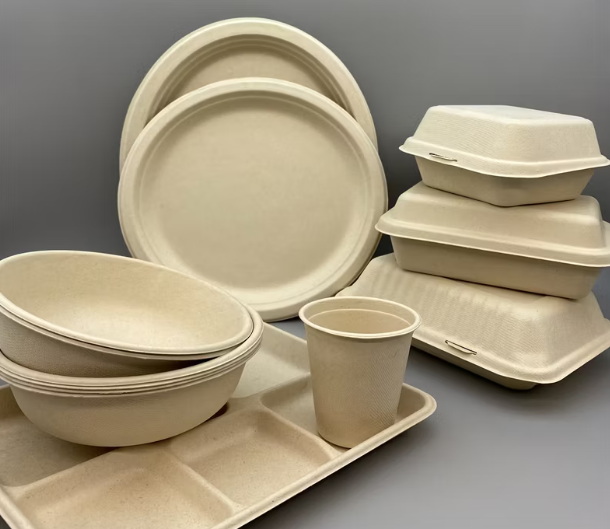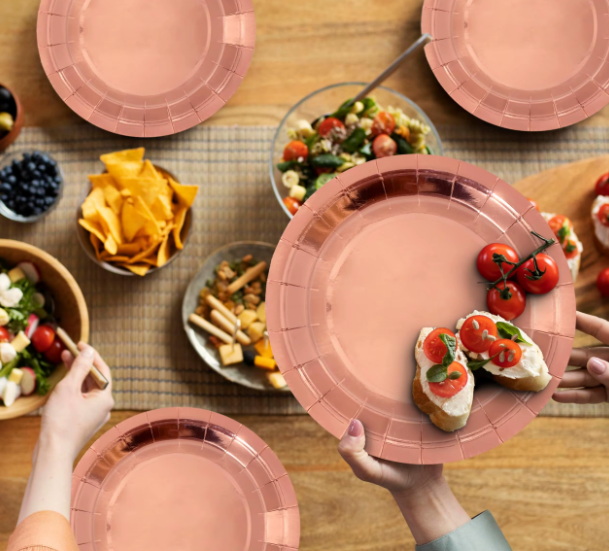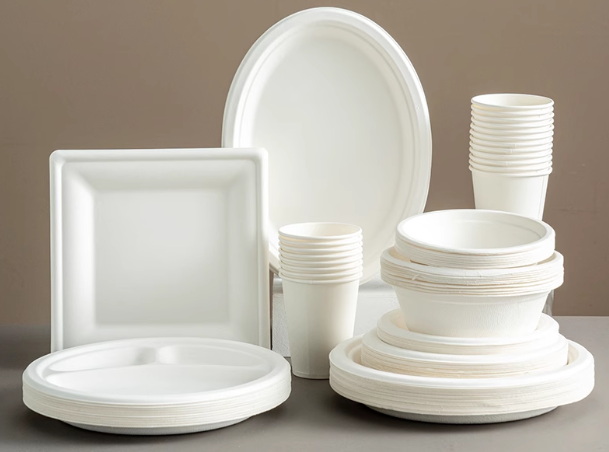
Content Menu
● What Is Designer Disposable Tableware?
>> Key Features of Designer Disposable Tableware
● The Environmental Impact of Traditional Disposable Tableware
>> Major Environmental Concerns
● The Emergence of Eco-Friendly Alternatives
>> Common Eco-Friendly Materials
● Design Innovations in Eco-Friendly Tableware
>> Current Design Trends
● Environmental Benefits of Designer Disposable Tableware
>> Environmental Advantages
>> Consumer Benefits
● Challenges and Limitations
>> Potential Drawbacks
● The Lifecycle of Eco-Friendly Designer Disposable Tableware
>> Lifecycle Stages
● Making Informed Choices as a Consumer
>> Tips for Choosing Eco-Friendly Designer Disposable Tableware
● The Future of Designer Disposable Tableware
>> Emerging Trends
● Conclusion
● FAQ
>> 1. What materials are commonly used in eco-friendly designer disposable tableware?
>> 2. How long does it take for compostable designer disposable tableware to break down?
>> 3. Is eco-friendly designer disposable tableware as durable as traditional plastic options?
>> 4. Can I compost eco-friendly designer disposable tableware at home?
>> 5. Are there stylish options available in eco-friendly designer disposable tableware?
In today's fast-paced world, convenience is often a top priority, especially when it comes to hosting events, parties, or even everyday dining. Disposable tableware has become a staple for its practicality, but it also raises significant environmental concerns. As awareness about sustainability grows, a new trend has emerged: designer disposable tableware that claims to be both elegant and eco-friendly. But is it truly possible for disposable tableware to combine style, convenience, and environmental responsibility? In this comprehensive article, we will explore the materials, design innovations, environmental benefits, challenges, and future of eco-friendly designer disposable tableware.

What Is Designer Disposable Tableware?
Designer disposable tableware refers to single-use plates, bowls, cups, and cutlery that are crafted with a focus on aesthetics and quality. Unlike traditional disposable products, which are often plain and utilitarian, designer options are intended to enhance the visual appeal of any dining experience. They are commonly used at weddings, upscale parties, corporate events, and other occasions where presentation matters as much as convenience.
Key Features of Designer Disposable Tableware
- Premium Materials: Designer disposable tableware often uses bamboo, palm leaf, bagasse, or high-quality paper.
- Attention to Detail: These products feature intricate patterns, textured finishes, and elegant shapes.
- Variety: Available in coordinated sets that mimic the look and feel of traditional dinnerware.
- Customization: Some brands offer personalized designs or branding options for special occasions.
The Environmental Impact of Traditional Disposable Tableware
Traditional disposable tableware, especially those made from plastics and Styrofoam, is notorious for its negative impact on the environment. The manufacturing process relies heavily on non-renewable resources, and the resulting waste can persist in landfills for generations. Additionally, plastic waste often ends up in oceans, posing a threat to marine life and ecosystems.
Major Environmental Concerns
- Resource Depletion: The production of plastic tableware consumes fossil fuels and other non-renewable resources.
- Pollution: Manufacturing processes release greenhouse gases and other pollutants.
- Persistence: Plastic and Styrofoam products take hundreds of years to decompose.
- Wildlife Harm: Improperly disposed items can endanger animals and contaminate water supplies.
The Emergence of Eco-Friendly Alternatives
Eco-friendly designer disposable tableware aims to address these issues by using sustainable materials and responsible manufacturing practices. The goal is to offer the same convenience and elegance, but with a significantly reduced environmental footprint.
Common Eco-Friendly Materials
- Bamboo: Fast-growing, renewable, and naturally compostable.
- Palm Leaf: Made from fallen leaves, biodegradable and visually appealing.
- Bagasse: A byproduct of sugarcane processing, sturdy and compostable.
- Wood: Sourced from responsibly managed forests, biodegradable and often certified.
These materials are chosen for their ability to break down naturally, returning nutrients to the earth rather than lingering as waste.
Design Innovations in Eco-Friendly Tableware
A common misconception is that eco-friendly products are less attractive or functional. However, modern designer disposable tableware challenges this notion by blending sustainability with style.
Current Design Trends
- Elegant Color Palettes: Soft hues and natural tones that complement any event theme.
- Textured Finishes: Embossed or patterned surfaces that mimic ceramics or fine china.
- Coordinated Sets: Plates, cups, and cutlery designed to match for a cohesive look.
- Personalization: Custom logos, monograms, or event-specific designs.
These innovations ensure that eco-friendly tableware not only performs well but also enhances the overall dining experience.
Environmental Benefits of Designer Disposable Tableware
Choosing eco-friendly designer disposable tableware offers significant advantages for both the planet and consumers.
Environmental Advantages
- Reduced Landfill Waste: Compostable materials break down quickly, minimizing landfill accumulation.
- Lower Carbon Footprint: Renewable resources and efficient manufacturing processes reduce emissions.
- Minimal Pollution: Fewer chemicals and less energy are used in production and disposal.
- Support for Sustainable Practices: Encourages responsible agriculture and forestry.
Consumer Benefits
- Stylish Presentation: Enhances the look of events without the need for traditional dinnerware.
- Durability: Many eco-friendly options are sturdy enough for hot foods and liquids.
- Safety: Free from harmful chemicals found in some plastics.
- Easy Cleanup: Offers the convenience of disposability without environmental guilt.

Challenges and Limitations
Despite their benefits, eco-friendly designer disposable tableware is not without challenges.
Potential Drawbacks
- Higher Cost: Sustainable materials and ethical production can make these products more expensive.
- Limited Availability: Not all regions have access to a wide variety of eco-friendly options.
- Composting Requirements: Some products require industrial composting facilities to break down fully.
- Greenwashing: Misleading marketing can make it difficult for consumers to identify genuinely sustainable products.
Overcoming these challenges requires consumer education, innovation, and investment in composting infrastructure.
The Lifecycle of Eco-Friendly Designer Disposable Tableware
To truly understand the sustainability of designer disposable tableware, it's important to consider its entire lifecycle-from sourcing to disposal.
Lifecycle Stages
- Sourcing: Materials like bamboo and sugarcane are grown sustainably, often with certifications to ensure responsible management.
- Manufacturing: Processes are optimized to minimize waste and emissions, with some companies adopting carbon-neutral practices.
- Usage: Designed for single use but built to be durable and attractive.
- Disposal: Compostable items break down quickly in the right conditions, supporting a circular economy.
Making Informed Choices as a Consumer
Consumers have a crucial role in promoting sustainable dining. By choosing designer disposable tableware made from eco-friendly materials, individuals and event planners can reduce their environmental impact while still enjoying convenience and style.
Tips for Choosing Eco-Friendly Designer Disposable Tableware
- Check Certifications: Look for labels like FSC or USDA Biobased.
- Understand Compostability: Know whether products are home-compostable or require industrial facilities.
- Research Brands: Choose companies with transparent sourcing and ethical manufacturing.
- Consider Packaging: Opt for products with minimal and recyclable packaging.
The Future of Designer Disposable Tableware
The industry is rapidly evolving, with ongoing innovations in materials, design, and production methods. As demand for sustainability grows, more brands are investing in research and development to create products that meet both aesthetic and environmental standards.
Emerging Trends
- New Materials: Use of agricultural waste and plant fibers for innovative products.
- Minimalist Packaging: Focus on recyclable or compostable packaging solutions.
- Customization: Increasing options for personalized designs.
- Infrastructure Growth: Expansion of composting facilities and recycling programs.
The future of designer disposable tableware is one where convenience, style, and sustainability coexist, offering consumers guilt-free options for every occasion.
Conclusion
Designer disposable tableware can indeed be eco-friendly when crafted from sustainable materials and produced with environmental responsibility in mind. Modern innovations have made it possible to enjoy the elegance and convenience of disposable products without sacrificing the health of our planet. By making informed choices and supporting brands committed to sustainability, consumers can contribute to a greener future-one stylish plate at a time.

FAQ
1. What materials are commonly used in eco-friendly designer disposable tableware?
Eco-friendly designer disposable tableware is often made from renewable resources such as bamboo, palm leaf, bagasse, and responsibly sourced wood. These materials are chosen for their ability to decompose naturally and their minimal environmental impact.
2. How long does it take for compostable designer disposable tableware to break down?
Compostable designer disposable tableware can break down within a few months under proper composting conditions. The exact timeframe depends on the material and the composting environment, but many products are designed to decompose quickly and efficiently.
3. Is eco-friendly designer disposable tableware as durable as traditional plastic options?
Yes, many eco-friendly designer disposable tableware products are designed to be sturdy and functional, often matching or exceeding the durability of traditional plastic or paper options. Materials like bamboo and bagasse are particularly known for their strength and heat resistance.
4. Can I compost eco-friendly designer disposable tableware at home?
Many compostable designer disposable tableware items can be composted at home, especially those made from bamboo, palm leaf, or bagasse. However, it is important to check product labels and local composting guidelines to ensure proper disposal.
5. Are there stylish options available in eco-friendly designer disposable tableware?
Absolutely. Modern eco-friendly designer disposable tableware comes in a wide range of styles, colors, and patterns, offering options that suit both casual and formal events. Innovations in design ensure that sustainability does not mean compromising on aesthetics.

















